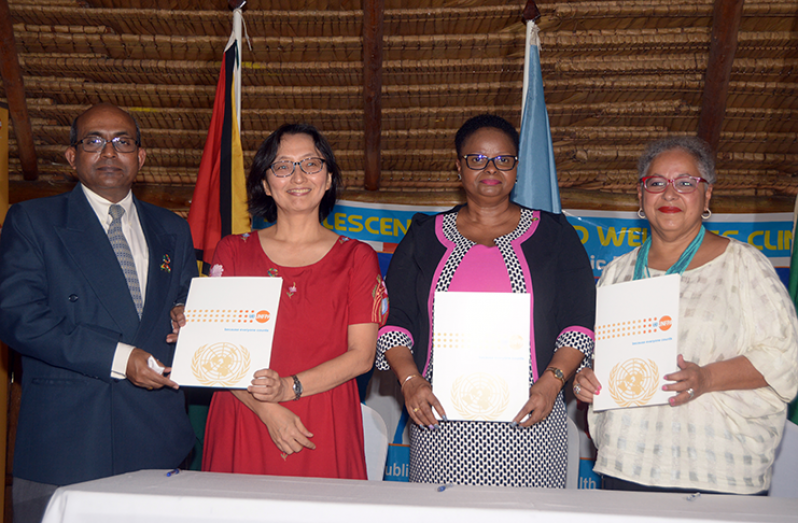– project launched to tackle problem in Regions 1, 9
THE government, with financial assistance through the India-United Nations (UN) Development Partnership Fund Project, will be looking to reduce adolescent pregnancy by 10 per cent in Regions One and Nine by 2021.
The project called “Reducing adolescent pregnancy in Guyana” was officially launched at the Sophia Exhibition Centre on Friday.
Teenage pregnancy is a national concern and the grant of US$559,000 will provide financing that will help Guyana to improve access to adolescent sexual reproductive health and quality services in community; establish an enabling environment towards sexual and reproductive health; and empower adolescents, parents and communities to prevent teenage pregnancy and achieve the overarching goal of reducing adolescent pregnancy by 10 per cent.
This was according to Public Health Minister, Volda Lawrence, during her remarks at the launch of the project.
“The Government of Guyana, through the Ministry of Public Health, is aware of the high levels of adolescent pregnancy plaguing our country… We have prioritised this issue on our health agenda,” said Minister Lawrence, adding that statistics have shown that Guyana has the highest rate of adolescent pregnancy in the English-speaking Caribbean.
The adolescent fertility is above average, especially among the indigenous girls, with a statistic of 74 out of every 1000 persons within the age group of 15-19 years old in Regions One, Seven and Nine.
“Our situation is critical and the recently conducted situation analysis on adolescents, pinpoints that compared to the other ethnic groups, the Indigenous People recorded the highest percentage of teenage pregnancy,” Lawrence outlined.
Some of the contributory factors were lack of access to contraceptives and comprehensive sexual education, risky sexual behaviour and early sex.
Lawrence believes that there is also an overriding factor that is many times overlooked and that is the cultural differences which exist.
“That is something that in everything we do, we must take into account whether it is Region One, Seven or Nine, we will find that as we move from one tribe to another, their cultural differences stand out,” she explained.
The ministry has since utilised the situational analysis to galvanise and take urgent action to address adolescent pregnancy.
PARTNERSHIP APPROACH

In appreciating the enormous challenges, the ministry has recognised that it could not address the problem singlehandedly and thereby sought the support of other local and international partners to tackle the problem.
Against that backdrop, the ministry made a commitment to align the Adolescent Health Unit with the strategic action outlined in the Global Strategy for Women, Children and Adolescent Health 2016-2030.
“Through the India-UN Development Partnership Fund, we are here and we will be signing that three-year project which will be implemented by the United Nations Population Fund (UNFPA) in Regions One and Nine,” said Lawrence.
She noted that government will still need to look at Region Seven since no one must be left behind.
The ministry’s focus for the targeted adolescent group includes adolescent- friendly health facilities; pregnancy support groups; community parenting groups; and all initiatives used to improve access to healthcare services.
UNFPA Sub-Regional Office for the Caribbean Director, Alison Drayton, said adolescents and youth must be provided with age-appropriate comprehensive sexuality education to develop the knowledge and skills they need to protect their health throughout their lives.
“Education and information are however not enough. Good, quality reproductive health services must be readily available to help adolescents make informed choices and be healthy,” she said.
She believes that with the support of the India-UN Development Partnership Fund, UNFPA and partners will be able to employ targeted interventions to reduce adolescent pregnancy in Regions One and Nine.
The two outcomes of the project are to strategically address capacity-building and increase access to sexual reproductive health information and services.
At the local level, communities should be provided with the infrastructure to deliver reproductive healthcare in a youth-friendly and sensitive way.
“Although today we are launching a new programme, we are already involved in strong collaborative solutions for reducing adolescent pregnancy, not only in Guyana but across the Region,” said Drayton.
The sub-regional office led the development of an integrated strategic framework for the reduction of adolescent pregnancy in the Caribbean.
This plan provides policy and operational platforms for sub-regional collaboration and generates political momentum.
GOAL
The goal is to reduce the number of adolescent pregnancies in each country in the English and Dutch-speaking Caribbean by at least 20 per cent this year.
According to the UNFPA, every day in developing countries, 20,000 girls under age 18 give birth. This amounts to 7.3 million births a year. And if all pregnancies are included, not just births, the number of adolescent pregnancies will be much higher.
When a girl becomes pregnant, her life can change radically. Her education may end and her job prospects diminish. She becomes more vulnerable to poverty and exclusion, and her health often suffers.
Complications from pregnancy and childbirth are the leading causes of death among adolescent girls.
Adolescent pregnancy is generally not the result of a deliberate choice – these girls often have little say over decisions affecting their lives. Rather, early pregnancy is a consequence of little or no access to school, information or healthcare.
The UNFPA works to address these issues by focusing on the protection and fulfilment of girls’ rights. This includes supporting comprehensive sexuality education and sexual and reproductive healthcare to help girls avoid pregnancy. UNFPA also advocates supporting girls who become pregnant so they can return to school and reach their full potential.
As Guyana embarks on the journey to address teenage pregnancy, the Indian High Commissioner to Guyana, Venkatachalam Mahalingam, and UN Resident Coordinator, Mikiko Tanaka, both wished Guyana success for the project.
The India-UN Development Partnership Fund is a dedicated facility within the United Nations Fund for South-South Cooperation established in 2017. It is supported and led by the Government of the Republic of India, managed by the United Nations Office for South-South Cooperation, and implemented in collaboration with the United Nations system.
The India-UN Development Partnership Fund supports Southern-owned and led, demand-driven, and transformational sustainable development projects across the developing world, with a focus on least developed countries and small Island developing states.




.png)









